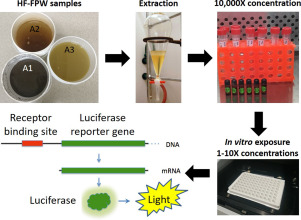Environment International ( IF 11.8 ) Pub Date : 2018-10-17 , DOI: 10.1016/j.envint.2018.10.014 Yuhe He , Yifeng Zhang , Jonathan W. Martin , Daniel S. Alessi , John P. Giesy , Greg G. Goss

|
Potential effects of horizontal drilling combined with high-volume hydraulic fracturing (HF) have drawn significant public concern, especially on the handling, treatment, and disposal of HF flowback and produced water (HF-FPW). Previous studies indicated HF-FPW could significantly disrupt biotransformation and expressions of genes related to the endocrine system. This study focused on effects of organic extracts of HF-FPW on receptor binding activity using several transactivation assays. Six HF-FPW samples were collected from 2 wells (Well A and Well B, 3 time points at each well). These were separated by filtration into aqueous (W) and particulate (S) phases, and organics were extracted from all 12 subsamples. Of all the tested fractions, sample B1-S had the greatest Σ13PAH (11,000 ng/L) and B3-S has the greatest Σ4alkyl-PAHs (16,000 ng/L). Nuclear receptor binding activity of all the extracts on aryl hydrocarbon receptor (AhR), estrogen receptor (ER), and androgen receptor (AR) were screened using H4IIE-luc, MVLN-luc, and MDA-kb2 cells, respectively. FPWs from various HF wells exhibited distinct nuclear receptor binding effects. The strongest AhR agonist activity was detected in B3-S, with 450 ± 20 μg BaP/L equivalency at 5 × exposure. The greatest ER agonist activity was detected in A1-W, with 5.3 ± 0.9 nM E2 equivalency at 10× exposures. There is a decreasing trend in ER agonist activity from A1 to A3 in both aqueous and particulate fractions from Well A, while there is an increasing trend in ER agonist activity from B1 to B3 in aqueous fractions from Well B. This study provides novel information on the sources of endocrine disruptive potentials in various HF-FPW considering both temporal and spatial variability. Results suggest that reclamation or remediation and risk assessment of HF-FPW spills likely requires multiple strategies including understanding the properties of each spill with respect to fractured geological formation and physiochemical properties of the injected fluid.
中文翻译:

从水力压裂回流和采出水(HF-FPW)中提取的有机部分的内分泌破坏潜力的体外评估
水平钻井结合大体积水力压裂(HF)的潜在影响引起了公众的广泛关注,尤其是在HF回流和采出水(HF-FPW)的处理,处理和处置方面。先前的研究表明,HF-FPW可以显着破坏与内分泌系统相关的基因的生物转化和表达。这项研究集中于使用几种反式激活法测定HF-FPW的有机提取物对受体结合活性的影响。从2口井(A井和B井,每个井有3个时间点)收集了六个HF-FPW样品。通过过滤将其分离为水相(W)和颗粒相(S),并从所有12个子样品中提取有机物。所有测试的级分,样品B1-S具有最大Σ 13PAH(11000纳克/升)和B3-S具有最大Σ 4烷基多环芳烃(16,000纳克/升)。使用H4IIE- luc,MVLN- luc筛选所有提取物对芳烃受体(AhR),雌激素受体(ER)和雄激素受体(AR)的核受体结合活性。,和MDA-kb2细胞。来自各种HF井的FPW表现出不同的核受体结合作用。在B3-S中检测到最强的AhR激动剂活性,当暴露5次时,BaP / L的当量值为450±20μg。在A1-W中检测到最大的ER激动剂活性,在10次暴露下的E2当量值为5.3±0.9 nM。从A1到A3的ER激动剂活性在A井的水相和颗粒中都有下降的趋势,而从B1到B3的ER激动剂活性在B井的水相中都有上升的趋势。考虑到时间和空间变异性,各种HF-FPW中内分泌破坏性电位的来源。结果表明HF-FPW溢出物的填海或整治以及风险评估可能需要多种策略,包括了解每种溢出物相对于裂缝地质构造和注入流体的理化特性的特性。



























 京公网安备 11010802027423号
京公网安备 11010802027423号